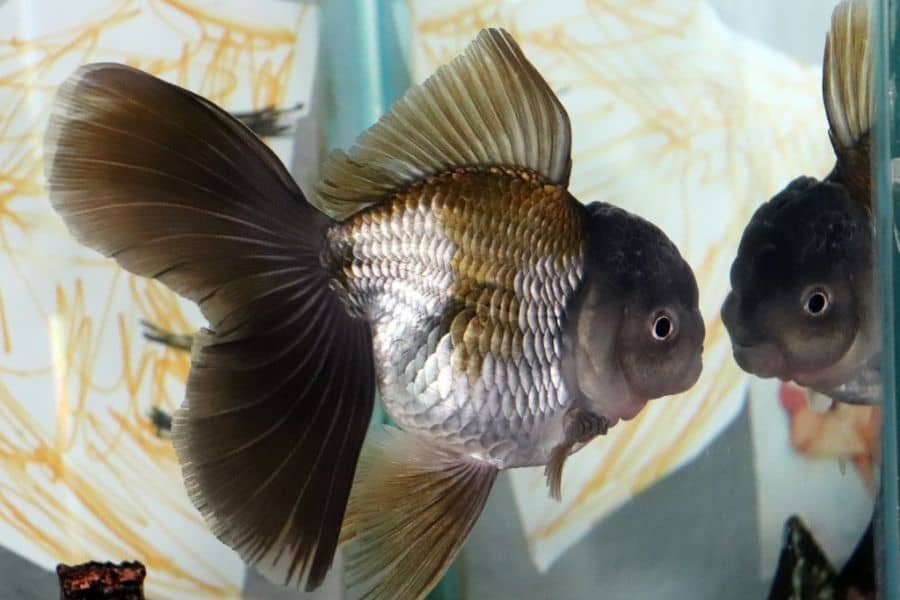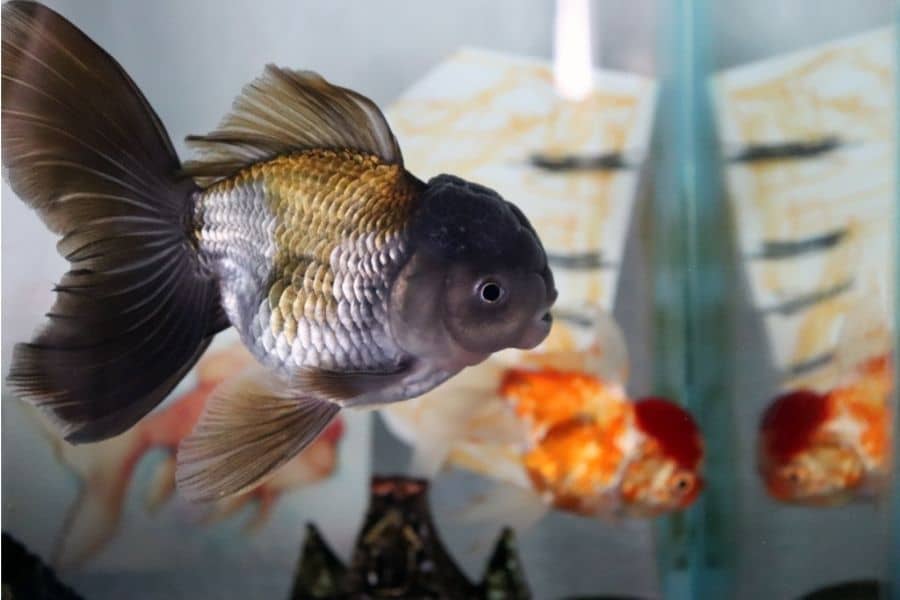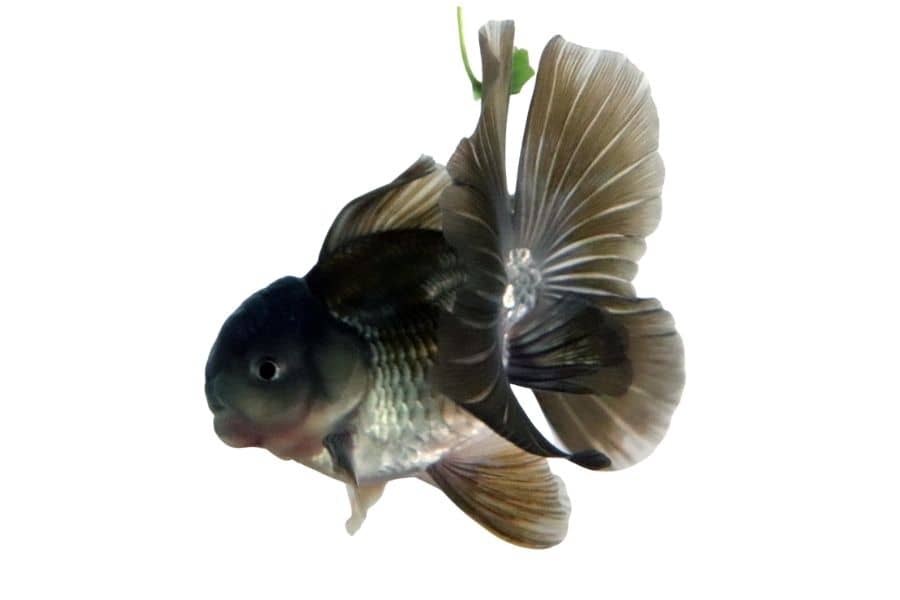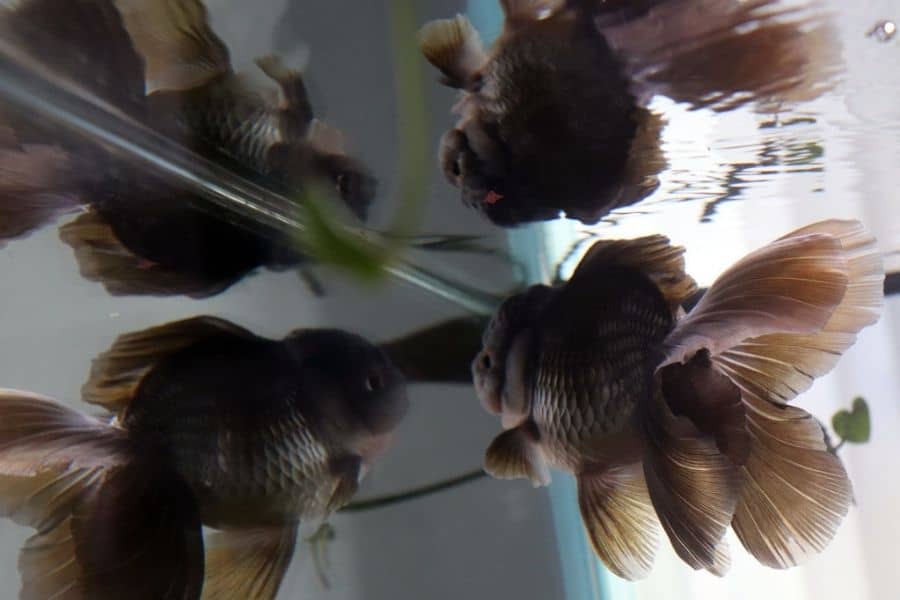The Blue Oranda Goldfish is a sophisticated fish that comes in distinct fins and a hood covering the head.
The blue color adds warmth to the color and looks like a nickel metallic body structure. The fish closely resemble the VeilTail Goldfish.

Origin of Blue oranda goldfish
Jump To
- 1 Origin of Blue oranda goldfish
- 2 Size of the Blue oranda goldfish
- 3 Life span of Blue oranda goldfish
- 4 Tank preparation for Blue oranda goldfish
- 5 Blue oranda goldfish tank mates
- 6 Cleaning your blue oranda goldfish tank
- 7 Feeding the blue oranda goldfish
- 8 Normal behaviour of the fish
- 9 Tank mates of blue oranda goldfish
- 10 Common Diseases
- 11 How to breed blue oranda goldfish
- 12 Difference between blue oranda goldfish fish and oranda goldfish
- 13 Special notes
- 14 FAQ
- 15 Conclusion:
The origin of the fish is unknown, but an early record of the fish shows that the species date back to the 15th century. They are a breed with different species and one of the fancy goldfish produced in east Asia.
Size of the Blue oranda goldfish
The average size of the fish reached 8 to 9 inches in length when they are fully grown.
Comparatively, the size of the fish is not massive, but the shape of the fish makes it look larger than the opponent in the aquarium.
Life span of Blue oranda goldfish
When the fish is kept in the proper living condition, they can survive up to 15 years.
You have to maintain their habitat the quality of the water to ensure that the fish is getting require nutrition in time.
The proper care can extend their lifespan and allow the fish to grow and live around 20 years of age without any trouble.
Tank preparation for Blue oranda goldfish

The Oranda Goldfish is not a speedy swimmer. They swim slowly and don’t move water much.
Many fish keepers keep them in the rounded glass bowl shape fish tank and the Goldfish has to live alone. Because they grow large, they need ample room to swim.
Oranda Goldfish would be happy to swim in a large size tank. Therefore, you should not keep them in a small tank. Chances are, the fish will develop anxiety and get sick.
Size of the tank:
You can place the Blue Oranda into the 300 Gallon aquarium or large to size fish tank. The backyard garden pond with a capacity of 180 gallons would also work.
Blue Oranda would appreciate it if you put some cold water plants that mimic the natural habitat of the fish. Remember that the Goldfish are natural diggers.
They will scatter the fine gravel and rocks while searching for the food at the bottom. It may injure the leaves or eat them if they are fed on time.
Water quality
Temperature
Preferred temperature range for blue oranda fish is from 65°F to 72°F. With moderated temperature to balance the water condition.
Ph
5.0 to 8.0. A neutral pH around 7.0
Hardness
4 to 20 dGH
Other
Fish prefer cooler water with a moderated pH balance. The fish is susceptible to the change in the water condition. It can easily find the slight change in the water and its pH level and react to it clearly.
Decoration
Put the freshwater with naturally found plants in the aquarium to mimic the natural habitat of the fish.
Filter system
The oranda goldfish produce a good amount of waste product.
You should have a powerful filter system to keep the water clean. The aquarium will get dirty in a short period.
If the waste product is not filtered, then it will increase the ammonia and nitrate levels in the water. To maintain the water quality, perform the 23 percent water change every 15 days and replace it with fresh water.
Aeration
The contaminated water reduces the Oxygen level in the water. For the freshwater fish to survive, they should be kept in a tank where it has a strong aeration system. It will keep the water well oxygenated and clean.
Blue oranda goldfish tank mates
The Blue oranda goldfish is friendly by nature. They can comfortably stay with any kind of fish. However, you should be very selective when you choose the mates for the Oranda Goldfish.
The Peppered catfish, leopard pleco or catfish from Ancistrus are some fo the fish type those are great tank mates.
These fish are also known for keeping their tank clean and useful. You need the mates to take care of the amount of waste the oranda goldfish produce in a day.
The fish which are sensitive to the waste product would not be suitable for the mates. The fish may develop anxiety and die as soon as the pH and ammonia level goes up.

Cleaning your blue oranda goldfish tank
Generally, experts recommend that you should clean the entire goldfish aquarium. Perform regular water change, and the water will look clean.
However, sometimes the interior of the tank becomes dirty, and it would be challenging to remove the waste product entirely trapped under the gravel with a water change.
In such a condition, you have to perform the cleaning to change the entire tank water and replace them with fresh water.
There are ways you should perform the cleaning of the Oranda Goldfish to avoid any injuries or health damage to the fish.
When the water is not breathable, serious spring cleaning must keep the water condition perfect for the Goldfish.
- The first thing that you need to do is arrange a temporary home for the Oranda goldfish.
- Ensure that the water is taken from the existing tank to avoid fish feeling stress when the water changes overnight.
- Use the fishnet to take out the fish and move them to the temporary container.
- Once the fish is moved, begin the cleaning of the fish tank.
- Remove the water and clean the gravel, synthetic plant and filter to remove the trapped waste in the cartridge.
- Ensure that no dirt is left in the tank. Else, when you put the filter back and activate the pump, it will start pumping out the waste product in the water.
- Put the equipment back in the tank, and pour the water into the tank.
- Use chlorine to clean the water and remove any harmful bacteria.
- Switch on the filter to make the water oxygen-rich. A few hours later, put the fish back in the tank.
Feeding the blue oranda goldfish
The Blue Oranda Goldfish doesn’t have a special dietary plan. They can eat regular fish food. The fish comes in the omnivores category. So feeding them would never be challenging.
Food type
The fish eat all types of fish food. You can offer them dry flakes and pallets. Even you can mix the dry food with nutritional vegetables such as spinach and lettuce.
You can also include high protein snacks in the diet such as brine shrimp, bloodworms, tubifex worms and Dhapnia.
Goldfish require a proper nutritional diet plan to flourish. When you feed the fish, ensure that you limit the protein to up to 30% of the diet.
Use the flake or pellet food to fulfill the nutrition requirement of the fish. Goldfish is an omnivorous creature that eats all kinds of dried and live foods.
However, you should control their diet or else they will develop a health problem.
You should offer a different kind of fish food filled with a high level of protein and nutrition. The nutrition helps the fish to grow quickly and stay healthy.
It will protect them from different diseases. Also, it helps the fish to be intact in their body colouration and look healthy.
Feeding frequency
Oranda goldfish need food once a day. Control their diet to avoid them to gain weight and become unhealthy.
Even if you put more food in the tank, they will not eat beyond their appetite. The food will be wasted, and it will get mixed up in the water, causing it to become dirty over time.
Overfeeding:
The overfeeding of the Oranda goldfish would make them gain weight. The excess weight is not natural for their body, and it will reduce their growth and produce health problem in them.
Normal behaviour of the fish

All goldfish type are peaceful fish. They live their lives in silence and enjoy the habitat without causing any damage to other fish.
They are never aggressive. So it will not cause any trouble to their mates. The slow swimmer roams around in the water comfortably.
They look for the food under the gravel, behind the rock and investigate the plant’s type. If they do not receive a sufficient amount of food, they will eat the plants. So ensure that you feed them regularly and on time.
Tank mates of blue oranda goldfish
Oranda Goldfish doesn’t have any problem living with other fish. However, this is too true in the inverse condition. The other fish may injure the Oranda goldfish.
Therefore, you should know what type of fish is great for having as tank mates with the Oranda goldfish.
You should keep the fish that share similar characteristics like blue oranda. Do not have aggressive fish in the water.
It may create trouble for the blue oranda goldfish and cause it to develop injuries. Also, some fish may start eating the fins of the Goldfish, which make the Goldfish unhealthy.
Here are some of the top contenders for the tank mates.
- Pearlscale Goldfish
- Sailfin Pleco
- Black Moors
- Pepper Cory Catfish
- Ryukin Goldfish
Common Diseases
The Oranda Goldfish develop several types of common disease when the water condition is not right.
Ich is the most common disease the fish develop when they are under stress.
The stress is developed when the water condition is not perfect. Also, the fluctuation in the pH level would cause the temperature to rise.
Additionally, the Oranda goldfish require proper filtration. The lack of filtration could be one reason why the Ich disease would develop and cause the Goldfish to die.
With the high amount of dirt and waste product in the water, the ammonia level would go up. It may also contribute to increasing the nitrate level in the water.
Always keep your filter clean and active at the highest performance level. If you find the filtration is dropping, you should immediately clean the cartridge or sponge placed in the water. Change the 25 per cent water every couple of weeks.
The disease is developed in the water when the water condition goes down. As soon the water becomes dirty, it will start producing bacteria from the waste product.
Also, Algae take place in the interior and the decorative stuff that supports the growth of the harmful bacteria. When the fish eats the algae with the good bacteria, the harmful bacteria will enter the fish body.
It will cause the fish to develop various health problem. If the situation is worst, the fish may die. You must keep the tank filled with fresh water and control the temperature regularly.
How to breed blue oranda goldfish

Beeding of blue oranda goldfish is standard as other fish breeding process works. They willingly breed when the fish is kept with the partners or group of male and female fish.
The breeding of the blue oranda goldfish should be done in a separate tank. Do not keep them in the main tank where other fish are available.
Put the fine leaf plants, decorative rocks, or other stuff in the tank to create a sufficient hiding place.
The fish lays the eggs in the leaves. The tank must have the feel of the natural habitat so the Goldfish can comfortably lay the eggs.
It should feel the environment is safe for the babies. The high stress level is not good for breeding.
Normally, the fish breed in the early hours of the day. The cheese each other and their body colour gets intensify, which shows they are ready to breed.
The oranda goldfish can lay around 10000 egg over several hours.
What should I do after laid the egg?
Once the eggs are laid and the fish swim comfortably without any spending time on the resting spot, it indicates the egg-laying process is complete.
Remove them both immediately. The adult fish would start eating the eggs they are kept in the tank for a long hour.
Once the eggs are laid, the hatching process will begin. It may take 2 to 3 days or some time for the eggs to get fully hatched, and the baby comes out from the egg.
Once the babies are out, use the liquid food for few days. After few weeks, use the baby brine shrimp to feed them. Keep the baby blue oranda goldfish in the proper care. Check the temperature regularly.
The filter should be kept on the moderated flow. Check none of the baby goldfish enters the filters and gets trapped in the flow.
When the baby blue oranda goldfish is fully grown, you can move them in the primary tank with other Goldfish.
During the breeding period, you should perform the normal temperature and water check. The level of ammonia and pH may go up depending on the number of goldfish babies are in the tank.
As the babies grow, they become more active and start eating anything they find around.
If your tank has natural plants, there are chances the Goldfish would eat them if they are not feeding properly.
During the early stage of growth, ensure that the babies are given the right amount of nutritional food. Use the proper diet plant to enable fast growth.
Difference between blue oranda goldfish fish and oranda goldfish
There are no many differences in care and food both the species would require. A significant difference is found in the colour of the fish. Also, the behaviour of the fish would be the same.
Special notes
Blue oranda goldfish is sensitive to their habitat. Minor changes to the water condition or the habitat could result in health problem in the fish. Poor care also contributes to injuries and health problem due to several diseases.
Therefore, it is vital to have a routine maintenance plan to keep the fish in good health. They need a simple diet plan.
Do not overfeed them also. Never underfeed them. If required, feed them in a small portion twice a day. They appear beautiful in the aquarium, and it can be exciting to have them in your aquarium.
FAQ
Are blue oranda goldfish aggressive?
Blue oranda goldfish are not like average Goldfish, which are aggressive by nature. The Blue oranda goldfish is peaceful and loving. They live comfortably with other peaceful fish in the aquarium.
Can a blue Moor and Oranda breed?
The blue moor and oranda can breed easily. The blue moor and oranda goldfish share similar behaviour. They love to live life in a peaceful environment. They are not aggressive by nature. Both the breed has many similar traits that make them perfect partner for each other.
Why are blue oranda goldfish turning orange?
There are several reasons why the blue oranda goldfish change its colours and turns to a completely different colour. The primary reason is the change in the environment.
When you bring the Goldfish from the store, the new environment may stress the fish, and it starts developing a high level of anxiety.
Other factors are the diet, light exposure in the tank, genetics, maturity, ageing, condition of the water, disease effect and illness. In most of the case, the changes occur during the first two years of goldfish life.
What is the Blue oranda goldfish lifespan?
In the perfect water condition and suitable habitat for the living, the blue oranda goldfish can live for 15 years. The age can be extended up to 20 years if you are a good fish keeper and understand the world of the fish very well.
Do blue oranda goldfish recognize their owners?
The study shows what the Goldfish can do to remember familiar faces. They can distinguish the common face from the different choices and accurately pinpoint the owner. Often they react to the person who feeds them regularly.
You may notice, the fish gets excited when you go close to the aquarium. Even from a distance, they can see and react to the activities such as swimming fast in front of the tank.
What is a giant blue oranda goldfish?
Giant blue oranda goldfish I, the epic fish type, is suitable for the large-sized tank or the backyard pond. They look awesome in the large size tank. The fish is visually mesmerising and a great choice to have them in the beautiful looking vertical tank.
Do blue moor goldfish eat other fish?
The blue moor goldfish are the omnivores who eat anything that they find around. They can eat the tiny fish which fits easily in their mouth.
The small size goldfish may not be able to eat the other fish due to their tiny size. However, as they grow, the size of the fish will grow, and they can become the fish-eater anytime. You should take care of the other fish if you have Goldfish and other fish together in the aquarium.
Both fish can eat each other if they are aggressive. Also, if the fish do not receive sufficient food, they become aggressive and start eating the fins of the other fish. Therefore, feeding the fish on time is necessary.
Conclusion:
Blue oranda goldfish care is essential for the fish keeper who has the blue oranda breed in their aquarium.
The beautiful is need special attention to keep them in good health.
Once they have reached adulthood, they become stronger with their immune system. However, still, the water condition and habitat would make their life difficult.
Right equipment may help you track the water condition and take the required action whenever the water shows the problem.
Temperature change is the most common problem you may encounter in your city. Use temperature management equipment to track the level of the temperature.
Goldfish are generally cold-water fish that cannot survive in the heat. The water temperature should be in the moderated condition. Change the 25 per cent of water weekly and add the freshwater to the tank. The nutritional water would keep the fish healthy.
Also, freshwater contains a high level of oxygen that supports the fish to stay in good shape. Any change in the water condition can be felt when the Goldfish start reacting weirdly.
If you find the fish are not eating or having trouble breathing, cleaning the entire fish tank is time. There are possibilities that the water is contaminated.
Cleaning is the only solution to eliminate the chemical-rich water and harmful bacteria produced by the dirty water. Clean everything that is part of the fish tank. The filter is the dirtiest part of the aquarium. You should focus on cleaning the filter thoroughly.
Read Next : 7 Best Nano Tanks For The New Fish Keeper | Comparison Read Next : Siamese Doll Goldfish Care 12 Things Must Know
